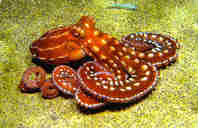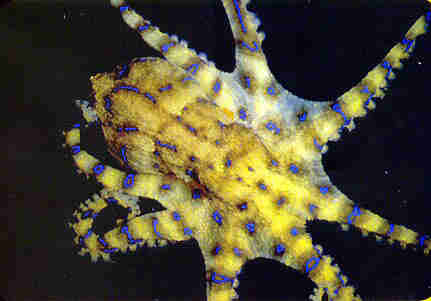OCTOPUS
 The
Octopus is a marine and carnivorous mollusc that lives in mild and tropical
waters all around the world. Octopus is characterized for having a soft body
with a well developed brain and 8 arms, each of which has two lines of
suckers.Like in the vertebrates, the octopuses big and complex eyes have lens,
which provide a keen vision. These animals are able to change, very fast, the
colour and texture of their skin depending on their condition. They can reach one
and half meters long and weigh 15 Kg.
The
Octopus is a marine and carnivorous mollusc that lives in mild and tropical
waters all around the world. Octopus is characterized for having a soft body
with a well developed brain and 8 arms, each of which has two lines of
suckers.Like in the vertebrates, the octopuses big and complex eyes have lens,
which provide a keen vision. These animals are able to change, very fast, the
colour and texture of their skin depending on their condition. They can reach one
and half meters long and weigh 15 Kg.
HABITAT
The
Octopus spends most of its life hiding, selecting natural holes between stones
or rubbles. There are cases of small species, like the pygmy octopus which
measures 2 cm long, that prefers to hide in the interior of an empty clam.
FEEDING
When
the octopus emerges to feed itself, it is a generality among bivalve molluscs and
crustaceans, it usually attracts its victims by shaking one of the tips of an arm
as if it was a worm. Another way of feeding itself, is by sliding
getting closer and finally plunging over the animal, sinking its teeth in
the interior of the wrapping or shell. On the other hand, octopuses are caught by
numerous species, like the European eel. When the octopus is just about to be
attacked, it sucks water into its mantle cavity emitting the water with strength
through the funnel. As a result a propelled escape of the octopus is obtained,
normally spiting ink.
REPRODUCTION
The
reproduction of the octopus takes place at the end of winter and in spring, with
a main concentration located near the coast.
A
male interested in the mating, comes closer enough to the female so that when
stretching out its changed arm, the hectocotyli, it is able to touch the female.
This arm has a deep wrinkle between the two lines of suckers and ends with the
shape of a spoon. After a period of attentiveness, the male inserts its arm
underneath the mantle of the female, and the sperms move down the wrinkle to the
oviduct of the female. A little while after the mating, the female starts laying
eggs in its lair. The laying is approximately of 150 thousands in two weeks time,
being each of them shut in a transparent capsule. The female protects them
during the next 50 days, throwing water jets to air, and cleans them. The
younglings of octopuses with white spots are only 3 cm long. They float on the surface and
become plankton for nearly one
month, then is when they submerge and start a new life in the sea. Normally, the
adult octopus, remains in a specific zone, but the species with plankton larvae
are found all around the world because they are taken away by marine currents
and tides.
CONSUMPTION
The
octopus is, without any doubt, the most popular of all cephalopods. Its meat is
appreciated for its high quality. It is commercialised fresh, frozen and canned.
SCIENTIFIC
CLASSIFICATION
The
octopuses belong to the Octopoda group.
Common Octopus is classified as Octopus
Vulgaris, pygmy octopus from the Atlantic Ocean as Octopus
joubini and octopus with white spots Octopus
macropus, being all in the Octopodidae
group.
NUTRITIONAL
INFORMATION
Approximated medium values for 100 grams of drained product:
| ·
Mineral
Salts |
1,95
g |
| ·
Proteins |
8,18
g |
| ·
Carbohydrates |
1,48
g |
| ·
Total
Fats |
0,54
g |
| ·
Neutral
Fats |
0,12
g |
| ·
Saturated
Fats |
0,058
g |
| ·
Mono-unsaturated
Fats |
0,016
g |
| · Polyunsaturated
Fats |
0,108
g |
| ·
Rich
in Essential Unsaturated Fats |
Omega
3 and Omega 6 |

Main Menu

 The
Octopus is a marine and carnivorous mollusc that lives in mild and tropical
waters all around the world. Octopus is characterized for having a soft body
with a well developed brain and 8 arms, each of which has two lines of
suckers.Like in the vertebrates, the octopuses big and complex eyes have lens,
which provide a keen vision. These animals are able to change, very fast, the
colour and texture of their skin depending on their condition. They can reach one
and half meters long and weigh 15 Kg.
The
Octopus is a marine and carnivorous mollusc that lives in mild and tropical
waters all around the world. Octopus is characterized for having a soft body
with a well developed brain and 8 arms, each of which has two lines of
suckers.Like in the vertebrates, the octopuses big and complex eyes have lens,
which provide a keen vision. These animals are able to change, very fast, the
colour and texture of their skin depending on their condition. They can reach one
and half meters long and weigh 15 Kg.